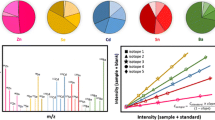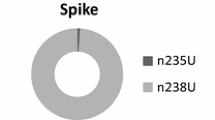Abstract
The combination of metrological weighing, the measurement of isotope amount ratios by a multicollector inductively coupled plasma mass spectrometer (MC-ICP-MS) and the use of high-purity reference materials are the cornerstones to achieve improved results for the amount content of lead in wine by the reversed isotope dilution technique. Isotope dilution mass spectrometry (IDMS) and reversed IDMS have the potential to be a so-called primary method, with which close comparability and well-stated combined measurement uncertainties can be obtained.
This work describes the detailed uncertainty budget determination using the ISO-GUM approach. The traces of lead in wine were separated from the matrix by ion exchange chromatography after HNO3/H2O2 microwave digestion. The thallium isotope amount ratio (n(205Tl)/n(203Tl)) was used to correct for mass discrimination using an exponential model approach. The corrected lead isotope amount ratio n(206Pb)/n(208Pb) for the isotopic standard SRM 981 measured in our laboratory was compared with ratio values considered to be the least uncertain. The result has been compared in a so-called pilot study "lead in wine" organised by the CCQM (Comité Consultatif pour la Quantité de Matière, BIPM, Paris; the highest measurement authority for analytical chemical measurements).
The result for the lead amount content k(Pb) and the corresponding expanded uncertainty U given by our laboratory was:
-
k(Pb)=1.329×10−10mol g−1 (amount content of lead in wine)
-
U[k(Pb)]=1.0×10−12mol g−1 (expanded uncertainty U=k×u c , k=2)
The uncertainty of the main influence parameter of the combined measurement uncertainty was determined to be the isotope amount ratio R 206,B of the blend between the enriched spike and the sample.




Similar content being viewed by others
Abbreviations
- X :
-
sample
- Y :
-
enriched isotopic spike material
- Z :
-
isotopic assay standard
- N A :
-
Avogadro constant
- k X :
-
amount content of the sample X (cf. ref. [5] for quantity k)
- k Y :
-
amount content of the spike Y
- k Z :
-
amount content of the assay standard Z
- m X :
-
mass of the sample X
- m Y :
-
mass of the spike Y (used for R B )
- m Z :
-
mass of the assay standard Z
- \(m'_Y \) :
-
mass of the spike Y (used for \(R'_B \))
- n :
-
amount of substance
- R :
-
corrected isotope amount ratio
- R′ :
-
measured isotope amount ratio
- R X :
-
isotope amount ratios of the sample
- R Y :
-
isotope amount ratio of the spike
- R B :
-
isotope amount ratio of the blend X and Y
- \(R'_B \) :
-
isotope amount ratio of the blend Z and Y
- R Z :
-
isotope amount ratio of the certified natural material
- R 204 :
-
isotope amount ratio n(204Pb)/n(208Pb)
- R 206 :
-
isotope amount ratio n(206Pb)/n(208Pb)
- R 207 :
-
isotope amount ratio n(207Pb)/n(208Pb)
- u X :
-
standard uncertainty of X
- u c :
-
combined measurement uncertainty
- k :
-
coverage factor (not to be confused with amount content)
- s :
-
standard deviation
- U :
-
expanded uncertainty
- R ref :
-
certified isotope amount ratio of the reference material
- R obs :
-
observed isotope amount ratio of the reference material
- Δm :
-
mass difference of measured isotope pair
- ε :
-
mass discrimination correction factor per mass unit
- OIML:
-
Organisation Internationale de la Métrologie Légale
- CCQM:
-
Comité Consultatif pour la Quantité de Matière
- IMEP:
-
International Measurement Evaluation Program
References
Watters RL Jr, Eberhardt KR, Beary ES, Fassett JD (1997) Metrologia 34:87–96
Milton MJT, Wiegolsz RI (2000) Metrologia 37(3):199–206
Platzner IT, Habfast K, Waldner AJ, Goetz A (1997) Modern isotope ratio measurement. In: Winefordner JD (ed) Chemical analysis, vol 145. Wiley, Chichester
Kochsiek M, Gläser M (eds) (2000) Comprehensive mass metrology, Wiley-VCH, Berlin
Cvitaš T (1996) Metrologia 33:35–39
Catanzaro EJ, Murphy TJ, Shields WR, Garner EL (1968) J Res Nat Bur Stand (US) 72A:261–267
ISO (1995) Guide to the expression of uncertainty in measurement, 2 edn. Geneva
Dunstan LP, Gramlich JW, Barnes IL, Purdy WC (1980) J Res Nat Bur Stand (US) 85(1):1–10
Todt W, Cliff RA, Hanser A, Hoffmann AW (1996) Evaluation of a lead double spike for high-precision lead isotope analysis. In: Basu A, Hart S (eds) Earth processes: reading the isotopic code. Geophysical monograph, American Geophysical Union, vol 95, pp 429–437
Rehkämper M, Mezger K (2000) J Anal At Spectrom 15:1451–1560
Hirata T (1996) Analyst 121:1407–1411
Wolff Briche CSJ, Harrington C, Catterick T, Fairman B (2001) Anal Chim Acta 437:1–10
Acknowledgements
The authors gratefully acknowledge the Institute of Reference Materials and Measurements (IRMM), the European Union Joint Research Center in Geel, Belgium for the wine sample which was used in the CCQM-P12 study on lead amount content in wine as well as some graphical representation of CCQM and IMEP data.
Author information
Authors and Affiliations
Corresponding author
Rights and permissions
About this article
Cite this article
Fortunato, G., Wunderli, S. Evaluation of the combined measurement uncertainty in isotope dilution by MC-ICP-MS. Anal Bioanal Chem 377, 111–116 (2003). https://doi.org/10.1007/s00216-003-2035-6
Received:
Revised:
Accepted:
Published:
Issue Date:
DOI: https://doi.org/10.1007/s00216-003-2035-6




